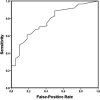Understanding the relationship between olfactory-specific quality of life, objective olfactory loss, and patient factors in chronic rhinosinusitis
- PMID: 28519966
- PMCID: PMC5751751
- DOI: 10.1002/alr.21940
Understanding the relationship between olfactory-specific quality of life, objective olfactory loss, and patient factors in chronic rhinosinusitis
Abstract
Background: Chronic rhinosinusitis (CRS) significantly impacts olfaction. However, the relationship between objective olfaction and patient-reported olfactory-specific quality of life (QOL) is not well understood. Furthermore, objective olfactory testing can be time consuming, so we sought to determine if patient-reported olfactory QOL can be used as screening tool for olfactory dysfunction.
Methods: Olfactory dysfunction was evaluated in 109 patients with CRS using the Questionnaire of Olfactory Disorders-Negative Statements (QOD-NS) and the Sniffin' Sticks Test, assessing for olfactory threshold, discrimination, identification, and overall composite scores (TDI; composite score of threshold, discrimination, and identification). Regression analysis was performed to correlate olfactory metrics and patient and disease-specific factors with QOD-NS scores. Optimal QOD-NS scores to classify patients based upon objective olfactory function were established.
Results: Bivariate and multivariate regression analyses of QOD-NS and CRS-associated comorbidities, objective measures of disease, demographics, and CRS-specific QOL were performed. Non-white race, depression, and worse 22-item Sino-Nasal Outcome Test (SNOT-22) scores correlated with worse QOD-NS scores (p < 0.005). Worse TDI scores correlated with worse QOD-NS scores, and discrimination had the strongest correlation (p < 0.001). Mean ± standard deviation (SD) QOD-NS scores for normosmia, hyposmia, and anosmia were 44 ± 7.2, 35.7 ± 12.8, and 31.6 ± 10.7, respectively. Receiver operating characteristic curve analysis revealed an area under the curve of 0.770 (p < 0.001), and a QOD-NS cutoff of 38.5 to have maximal Youden's index to define normal vs abnormal TDI score.
Conclusion: In CRS, QOD-NS correlates with non-white race, depression, SNOT-22, and TDI score, with discrimination having the strongest correlation. The QOD-NS also appears to be a feasible tool for olfaction screening.
Keywords: chronic sinusitis; olfaction; quality of life; smell loss; sniffin' sticks.
© 2017 ARS-AAOA, LLC.
Conflict of interest statement
Figures
References
MeSH terms
Grants and funding
LinkOut - more resources
Full Text Sources
Other Literature Sources
Medical
Miscellaneous


